Related Research Articles
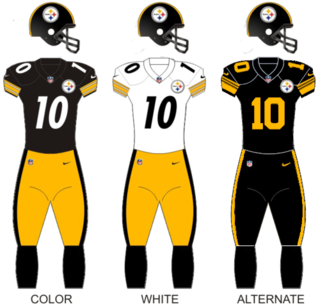
The Pittsburgh Steelers are a professional American football team based in Pittsburgh. The Steelers compete in the National Football League (NFL) as a member club of the American Football Conference (AFC) North Division. Founded in 1933, the Steelers are the seventh-oldest franchise in the NFL, and the oldest franchise in the AFC.
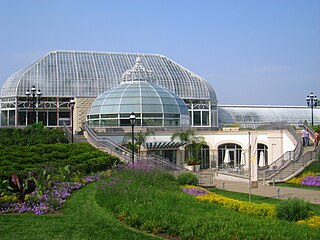
Pittsburgh is a city in the Commonwealth of Pennsylvania and the county seat of Allegheny County. It is the second-most populous city in Pennsylvania after Philadelphia and the 68th-most populous city in the U.S. with a population of 302,971 as of the 2020 census. The city anchors the Pittsburgh metropolitan area of Western Pennsylvania; its population of 2.457 million is the largest in both the Ohio Valley and Appalachia, the second-largest in Pennsylvania, and the 26th-largest in the U.S. Pittsburgh is the principal city of the greater Pittsburgh–Weirton–Steubenville combined statistical area that extends into two neighboring states, Ohio and West Virginia.

The U.S. Steel Tower, also known as the Steel Building, UPMC Building, or USX Tower (1988–2001), is a 64-story skyscraper at 600 Grant Street in downtown Pittsburgh, Pennsylvania. The interior has 2,300,000 sq ft (210,000 m2) of leasable space. At 256.3 m (841 ft) tall, it is the tallest building in Pittsburgh. It held its opening dedication on September 30, 1971.

Acrisure Stadium, formerly known as Heinz Field, is a football stadium located in the North Shore neighborhood of Pittsburgh, Pennsylvania, United States. It primarily serves as the home of the Pittsburgh Steelers of the National Football League (NFL) and the Pittsburgh Panthers of the NCAA Division I Football Bowl Subdivision in the Atlantic Coast Conference (ACC). The stadium opened in 2001 as Heinz Field, following the controlled implosion of the teams' previous home, Three Rivers Stadium. In 2021, the H. J. Heinz Company declined to renew the stadium's naming rights. The City of Pittsburgh green-lit Acrisure's bid to purchase the rights in 2022.

Hazelwood is a neighborhood of Pittsburgh, Pennsylvania in the United States. It is represented on Pittsburgh City Council by Barb Warwick. It is bordered by Greenfield and Oakland on the north, Squirrel Hill and Glen Hazel on the east, and the Monongahela River on the south and west. The Pittsburgh Bureau of Fire houses 13 Engine and 13 Truck in Hazelwood.
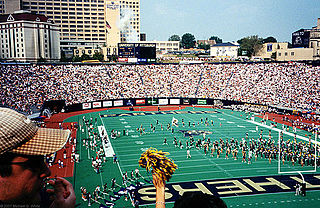
Pitt Stadium was an outdoor athletic stadium in the eastern United States, located on the campus of the University of Pittsburgh in the Oakland neighborhood of Pittsburgh, Pennsylvania. Opened in 1925, it served primarily as the home of the university's Pittsburgh Panthers football team through 1999. It was also used for other sporting events, including basketball, soccer, baseball, track and field, rifle, and gymnastics.
Aus-Rotten was an American crust punk band formed in Pittsburgh, Pennsylvania. Active from 1991 to 2001, its members practiced and promoted a philosophy of anarchist politics. The band included lead vocalist Dave Trenga, vocalist/guitarist Eric Good, bassist Corey Lyons, and drummer Matt Garabedian. Spitboy singer Adrienne Droogas would often join the band in their later material. The band's name comes from the German verb ausrotten, which translates to "exterminate" or "eradicate".
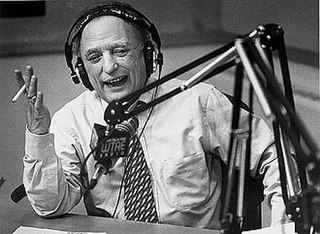
Myron Sidney Kopelman, known professionally as Myron Cope, was an American sports journalist, radio personality, and sportscaster. He is best known for being "the voice of the Pittsburgh Steelers".
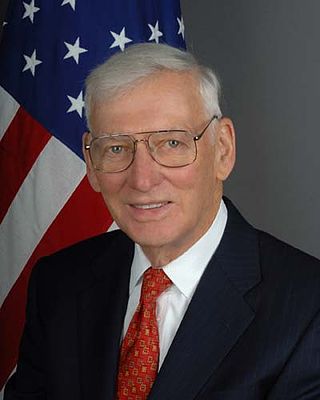
Daniel Milton Rooney was an American executive and diplomat best known for his association with the Pittsburgh Steelers, an American football team in the National Football League (NFL), and son of the Steelers' founder, Art Rooney. He held various roles within the organization, most notably as president, owner and chairman.
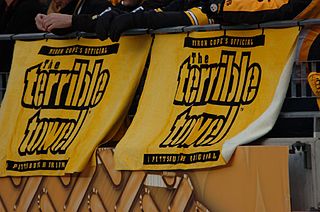
The Terrible Towel is a rally towel associated with the Pittsburgh Steelers, an American football team in the National Football League (NFL). The Terrible Towel has spread in popularity; for example, fans take their Towel to famous sites while on vacation. The Towel has been taken to the peak of Mount Everest, and even into space on the International Space Station. It is widely recognized as a symbol of the Steelers and the city of Pittsburgh.

Robert Patrick "Rocky" Bleier is an American former professional football player and a veteran of the United States Army. He played as a running back in the National Football League (NFL) for the Pittsburgh Steelers in 1968 and from 1970 to 1980.
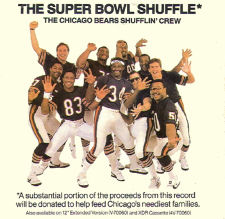
"The Super Bowl Shuffle" is a song performed by the Chicago Bears football team in 1985. It was released in December 1985 on Chicago-based Red Label Records and distributed through Capitol Records seven weeks ahead of their win in Super Bowl XX. The song peaked at number 41 on the US Billboard Hot 100, and earned a Grammy nomination for Best R&B Performance by a Duo or Group with Vocals in 1987.

Steeler Nation is an official name for the fan-base of the National Football League's Pittsburgh Steelers. The term was coined by NFL Films narrator John Facenda in the team's 1978 highlights film. Steelers Country is often used for the Pittsburgh, Pennsylvania, area where the fan base originates or for areas with a large Steelers fan base.

Michael Pettaway Tomlin is an American football coach who is the head coach for the Pittsburgh Steelers in the National Football League (NFL). Since joining the Steelers in 2007, he has led the team to eleven playoff runs, seven division titles, three AFC Championship Games, two Super Bowl appearances, and a title in Super Bowl XLIII. At age 36, Tomlin became the youngest head coach to win the Super Bowl, a record which was later broken by Sean McVay in Super Bowl LVI. Tomlin holds the record for most consecutive non-losing seasons to begin a coaching career with 17 and has never had a losing season. Only Tom Landry (21) and Bill Belichick (19) have had longer such streaks at any point in their coaching careers.

Sports in Pittsburgh have been played dating back to the American Civil War. Baseball, hockey, and the first professional American football game had been played in the city by 1892. Pittsburgh was first known as the "City of Champions" when the Pittsburgh Pirates, Pittsburgh Panthers football team, and Pittsburgh Steelers won multiple championships in the 1970s. Today, the city has three major professional sports franchises, the Pirates, Steelers, and Penguins; while the University of Pittsburgh Panthers compete in a Division I Power Five conference, the highest level of collegiate athletics in the United States, in both football and basketball. Local universities Duquesne and Robert Morris also field Division I teams in men's and women's basketball and Division I FCS teams in football. Robert Morris also fields Division I men's and women's ice hockey teams.
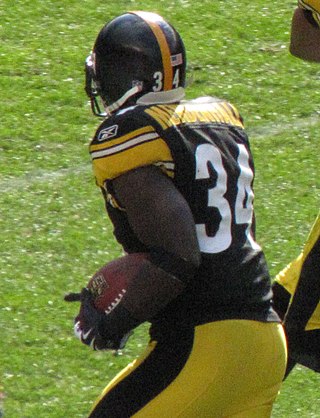
Rashard Jamal Mendenhall is an American former professional football player who was a running back for six seasons in the National Football League (NFL). He played college football for the Illinois Fighting Illini and was selected by the Pittsburgh Steelers in the first round of the 2008 NFL Draft. He won Super Bowl XLIII with the Steelers against the Arizona Cardinals, for whom he later played one season. After his career, he became a writer for the television series Ballers writing 30 episodes of the series.
The 2008 Pittsburgh Steelers season was the franchise's 76th season in the National Football League (NFL). The season concluded with the team winning Super Bowl XLIII to become the first franchise in the NFL with six Super Bowl titles.

"Hail to Pitt" is the most traditional fight song of the University of Pittsburgh, which is commonly referred to as Pitt. The saying "Hail to Pitt!" is also the most traditional and commonly used slogan of the University of Pittsburgh and its athletics teams. The slogan is frequently used in promotional material, printed on merchandise and souvenirs. It was also the title of a 1982 history of Pitt athletics by author Jim O'Brien. The slogan is often used among alumni as a statement of affiliation, including as a closing signature in conversation or correspondence between alumni, and is sometime abbreviated as "HTP" or "H2P", the latter of which is a registered trademark of the university and is frequently used on official university signage and merchandise.

The "Pitt Victory Song", one of the most popular and widely used fight songs of the University of Pittsburgh, is often played in conjunction with "Hail to Pitt" and the "Panther Song". It was originally written by former to students of the university in order to solve the issue of the university not owning the copyright to "Hail to Pitt" which prevented the school from granting permission for its use during football radio broadcasts. Lyrics were written by G. Norman Reis and Louis M. Fushan. Music was written by Benjamin Levant. The song debuted in the Cap and Gown Club's 1938 musical production entitled Pickets, Please! Although commonly performed at university events, few people today know the rarely heard first portion of the song that occurs before the chorus. However, the most common cheer that is used during Pitt-related events and athletic contests is "Let's go Pitt!", which while perhaps derived from the song's lyrics, is often cheered even in absence of the song or music.

The alma mater of the University of Pittsburgh was adopted soon after the University changed its name in 1908 from the Western University of Pennsylvania to its current moniker. Lyrics were written by George M. P. Baird, class of 1909 and were set to the tune of what was then the Austrian National Anthem. A new tune for the "Alma Mater" hymn was composed by Charles W. Scovel, class of 1883, but it was not widely adopted and was either lost or became obscure.
References
- ↑ Starr, Pamela (2006-01-30). "Wood's tune music to fan's ears". Pittsburgh Tribune-Review. Archived from the original on 2009-12-01. Retrieved 2009-04-22.
- ↑ Steelers Fight Song Homepage
- ↑ Dunlap, Colin (2006-09-07). "'Here We Go' -- Steelers catchy fight song is in need of changes". Pittsburgh Post-Gazette.
- ↑ Sergio Makaroff lyrics - Here We Go Steelers (New Roethlisberger Version)